Background
Quarantine was initially thought around its main mechanic - the designer, Mark Klassen, wanted to create a game in which players built something, each part representing a special ability or function. This build-up, in some way, had to be under control of the player, but susceptible to attacks from opponents—so you needed to grow your building with caution, so as not to attract too much attention from opponents.

With the idea and mechanics already developed, a theme was needed. Since Mark Klassen has a background in health care, it all came together - rooms with specific functions for specific treatments, which would need to accommodate patients, and the risk that the disease could spread, with help from opponents.
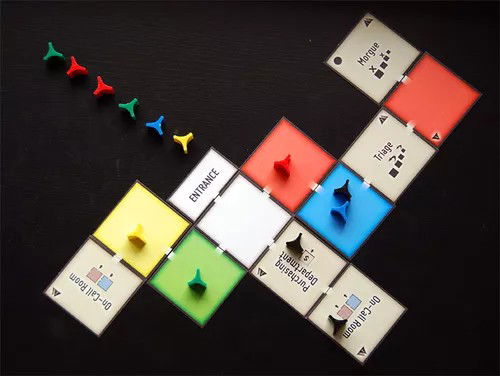
After the protoype came playtests, art design, etc., and then it was time to look for a publisher. That's when Mark Klassen got a call from Kevin Nesbitt, co-founder of a new company, Mercury Games. They loved the game, and it became their first official release. They hit jackpot!

And that's the story behind Quarantine's creation!
Quarantine - Game Info
Quarantine is a 2-to-4 players game, age 13+, by designer Mark Klassen. Art by Michael Christopher.
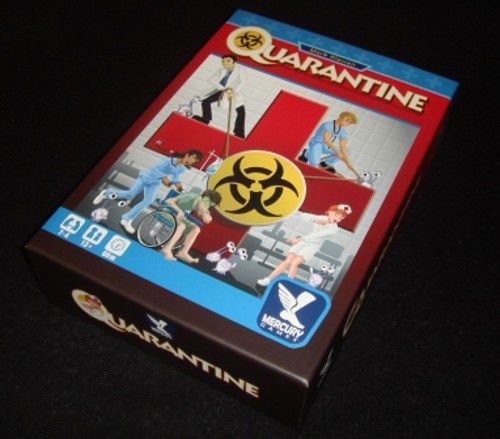
Quarantine was released in 2013 by Mercury Games, but so far hasn't been released in Brazil. The main mechanics involve: tile placement, and action points.
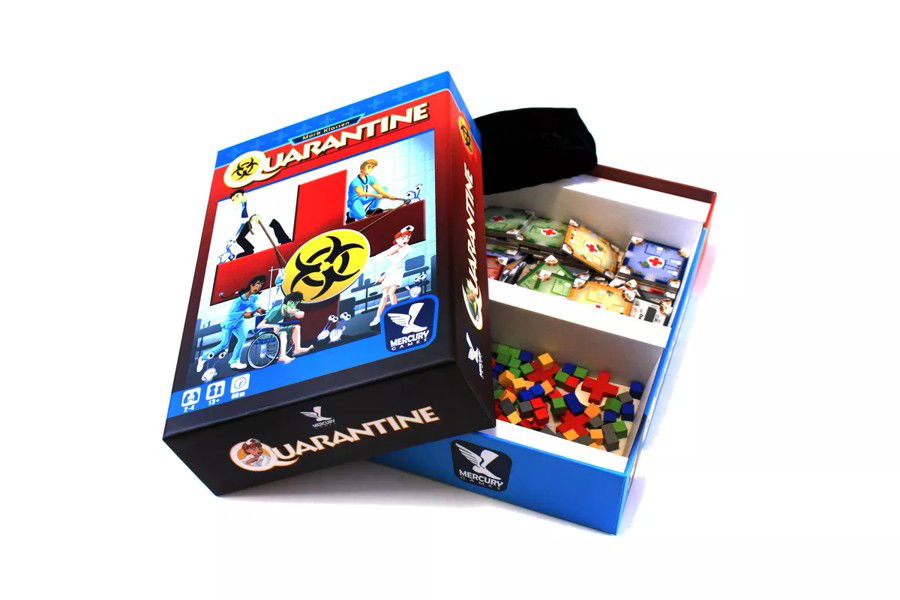
The Game
You manage a hospital full of patients, including some that were denied treatment on other hospitals due to infections.
You must have rooms to meet the growing demand, so invest in additional treatment wings and special rooms to make your hospital unique. Take care of your nurse stations, to keep infections from spreading. Prevent your hospital from being quarantined!
This is the Quarantine background!
Here's the game setup:
- Each player receives 1 lobby tile - the main one for their hospital;
- Each player receives 4 initial treatment room tiles, 1 for each color;
- Each player arranges their lobby and room tiles as they wish, but ensures that all rooms are accessible from the entrance;
- Draw 8 of the 14 special room tiles;
- Place the 4 additional treatment room tiles in the game;
- For both the special rooms and the additional treatment rooms, there are only two copies of each of these tiles in the game - they will start in the market, in the center of the table;
- Place all patient cubes in the bag;
- Place the 8 bonus action tokens next to the market;
- deternime who will be the 1st player, give them the 4 white round action discs;
- give the bag to the player to the left of the starting player.
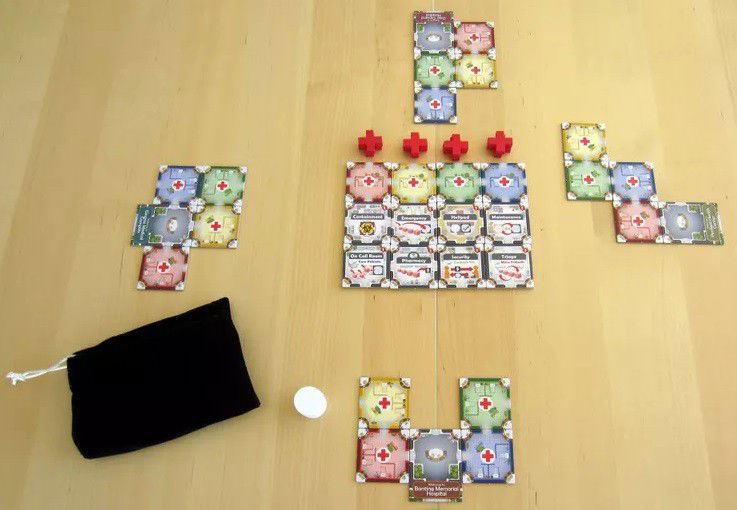
A turn in Quarantine is very straightforward, and there's a little tip to help: just remember the mantra "4 + 4"!
- 1) receive 4 Patients;
- 2) perform 4 Actions.
The player can freely sequence their turn, i.e.:
- receive 4 patients, and then perform their 4 actions;
- perform their 4 actions, and then receive their 4 patients;
- alternate between receiving patients and performing their actions.
Remeber to make this very clear to all player at the start of the game, as it really makes a difference. Don't forget it.
To receive your patients, simply tell the player on your left: New patient! The player to your left will then draw one of the patient cubes from the bag and give it to you. Here's what you can do with the patient:
- place it at the end of your hospital queue;
- place it at the end of another hospital's queue;
- if it's an infected patient, place it directly in one of your rooms or in a room at another hospital - which, by the way, cannot be denied.
Obviously, you don't want an infected patient in your hospital, given the risk of spreading the disease, and thus quarantining some of your wards. So, as a rule, you should place infected patients in your opponent's hospitals.

When performing the four actions, there are eight to choose from:
- Admit patients: Assign, if possible, all patients on your waiting list to rooms in your hospital;
- Cure patients: Cure all patients with the same illness (with the same color);
- Open a contract: Place an offer to purchase one of the special rooms;
- Purchase a room: It can be a special room or an additional treatment room;
- Move patients: Re-organize the waiting list at the entrance to your hospital;
- Get a Bonus Action: This allows you to have more actions in the next round;
- Decontaminate: Get rid of the contamination in one of your rooms;
- Renovate: Adjust the rooms in your hospital to a different configuration, facilitating access.
Let's talk a little about each action. Admit patients is one of the basic actions of the game; after all, patients have to leave the waiting list, and your hospital is there to attend them. Place them in the rooms of their respective colors until a patient of a specific color can no longer enter because the rooms of their color are all occupied.
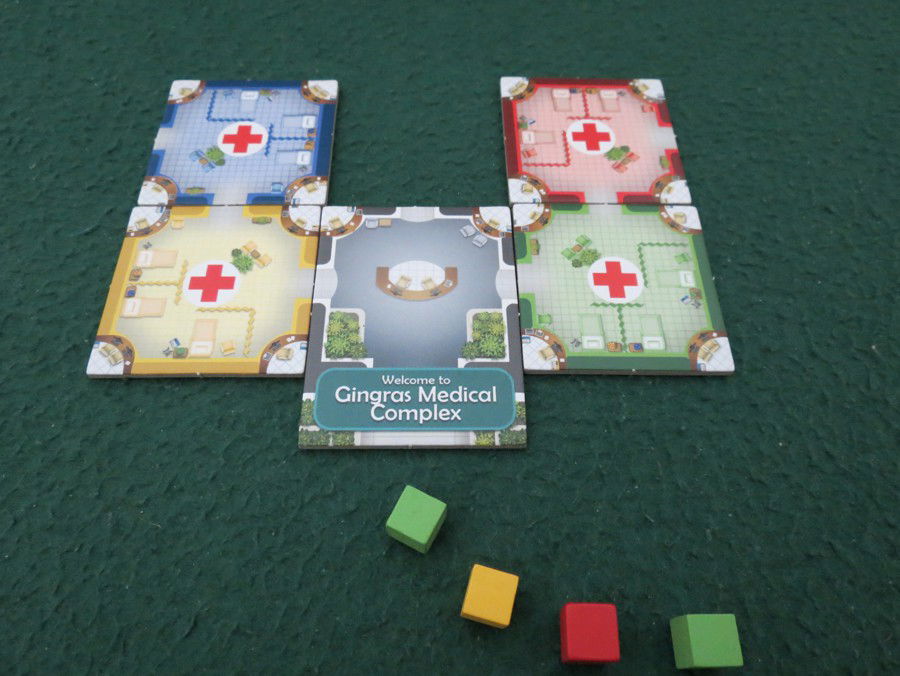
You can manage the waiting line with another action, moving patients, which allows you to re-organize the patients in any order you desire. Another way to mitigate this is by purchasing a room, that is, increasing your hospital's capacity and specialties.
Additional rooms are color-coded and allow you to treat specific patients. Special rooms will differentiate your hospital, since they include waiting rooms, nurse stations, pharmacy, cafeteria, pathology room, an emergency room, laboratory, and so on. All of these add advantages and unique features to your hospital, significantly improving its performance.

These rooms can only be purchased if a player, even yourself, opens a contract to put them available on the market, for a price set by whoever opened the contract.
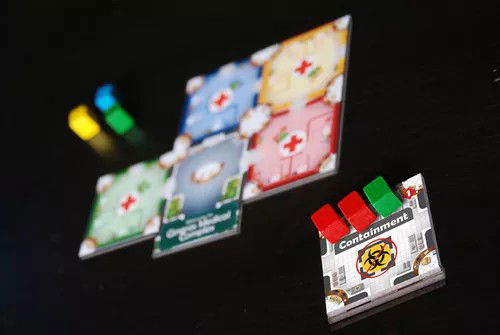
After settling the patients into their rooms, it's time to cure the patients. Each time you perform this action, cure all patients of one color (or disease) in your hospital. The great thing about this action is that the patient cubes, once cured, now represent the money your hospital received for the treatment. In other words, this is the money you will now use to purchase more rooms and special rooms.
To perform more than 4 actions on a turn, you must've taken a bonus action on the previous turn. You prepare your next turn to have more than 4 actions.

When, and if, your hospital is contaminated, because an infected patient was sent to your hospital, it is necessary to decontaminate, which is done one room at a time. Remember:
- a contaminated room prevents you from admitting or treating a patient in that room;
- if the contamination is in your hospital lobby, the entrance is blocked;
- if the contamination is adjacent to a nurse station, the infection spreads.
The nurse stations are located in the corners of the room tiles, and when four room corners meet, they form a circle, which means it's complete.
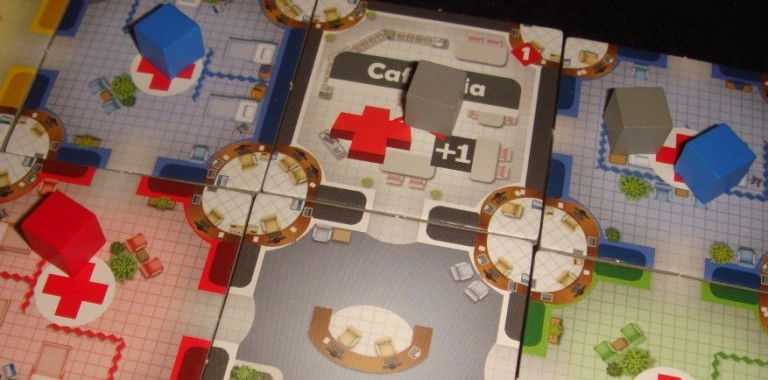
Lastly, once your hospital grows and there's no more room for expansion, it's time for renovation—that is, adjusting your hospital's rooms to a different configuration, facilitating and/or opening access to more rooms.
This is a turn in Quarantine!
Ending the Game
The game ends when any of the following events happen:
- the last room tile in the game is drawn;
- the last patient cube is drawn from the bag.
The current player finishes their turn, and all other players will play one more turn.
Important: No new patients will be drawn from the bag in this final round, regardless of how the end was triggered.
You score 1 point for each:
- Special room tiles in your hospital;
- Complete Nurse Stations in your hospital;
- 2 cubes (from cured patients) in your personal supply;
- No patients in your waiting line.
If there is a tie, the winner is the player with the fewest room tiles in their hospital. If the game is still tied, the winner is the player with the fewest nurse stations in their hospital. If the game is still tied, the winner is the player who hasn't been sick the longest.
Strategy Tips
If you like the hospital theme and want a cool management game, Quarantine is for you!
In Quarantine, everything fits together; you do things in a logical order and manage your resources well. It sounds easy, but it's not, and that's exactly where the fun and strategy of the game lies. Everything is limited: actions, patients, rooms, special rooms, and so on. Managing this according to the types of patients in your waiting list is really cool. No two matches will be the same.
At the beginning of your shift, the fact that you can choose the order to perform actions, or admit patients, or even combine them, is very strategic. You'll assess the available rooms in your hospital, the types of patients in your waiting list, and the rooms available on the market, which is very dynamic and makes the game even more fun. You really need to look at the big picture to do well.
Regarding actions, admitting patients only makes sense if you have enough available rooms in your hospital; otherwise, it's a poorly used action. Some special rooms allow you to reassign patients, or you can spend an action and reassign them before admitting more patients.
Curing patients is necessary, and converts cubes into in-game currency, which is very important to acquire new rooms and special rooms. You can open a contract and price it with values (in terms of quantity and color) that your opponents can't afford, thus ensuring you can buy that room when it's your turn again.
Also, when someone buys a special room that you set a price, they'll pay you for that room. So, it's a very good strategy to open contracts, but make sure you price them correctly (in terms of cubes and colors).
Buying additional treatment rooms is somewhat mandatory, as there are few available. They don't provide any extra benefit beyond providing more rooms in the colors you need, simple as that, but they help a lot.
Spending an action to get bonus actions next turn sounds crazy, but sometimes you have nothing else to do on your turn, either due to a lack of rooms or because you don't have any patients to cure or waiting in line. So, with the remaining action, you acquire a bonus action for the next turn. Remember: you're only allowed to buy two bonus actions per turn. This makes it even more strategic!
When your hospital is quarantined with infected patients, you must cure them right away. If you have a Laboratory in your hospital, you can turn infected patients in currency, once they're cured. This is another example of what special rooms can do for you, but remember, there are only 14 special rooms in the entire game, and only 8 are available in each match. Consider each special room's bonus and plan your best strategy for them.
Finally, an action that I don't use very often: renovating. After all, if you're already building your hospital in the best way possible, this should be unneeded. If you're somewhat careless, you'll use it; otherwise, it's rarely present in the game.
Based on these tips, develop your best strategy, manage your hospital effectively, have more options for your patients, and win in Quarantine!
Rules and Gameplay Videos
Rules:
Gameplay:
Pedagogical Tips
Quarantine is language-independent, which is great for kids, easy to teach and learn, and very visual, all of which is in addition to the excellent game-playing stimuli.
The entire game is about management: rooms, fees, patients, space—in short, kids will learn how to manage by playing. Logical thinking also comes along, with actions being thought through in order. They will learn without realizing it.
Mathematical reasoning is used constantly as they will have to calculate the size and variety of their queue to determine whether the hospital can handle it. Also, when cured, patients are converted into money, which is used to purchase new rooms and special rooms. These are small calculations involving quantity and color - excellent stimuli!
The decision to purchase a new room or special room will perhaps be the biggest challenge for children, as they'll have to price it with what they have. In other words, they can't set a price so low that everyone can buy it beforehand, nor so high that no one buys it and it ends up being too expensive for them. Children will learn this "middle ground" over time, but it will be a good lesson.
Finally, there is the hospital theme. For little children, I recommend treating it in a light and relaxed way. Play games like patients have scraped their legs, fallen off their bikes, etc. In other words, let the children decide what each patient's needs will be; their imagination will dictate the fun.
Pedagogically, Quarantine encourages management, strategy, decision-making, logical and mathematical reasoning, and on top of that, it's fun!
I recommend Quarantine for your collection!!!













— Comentarios 0
, Reacciones 1
Se el primero en comentar